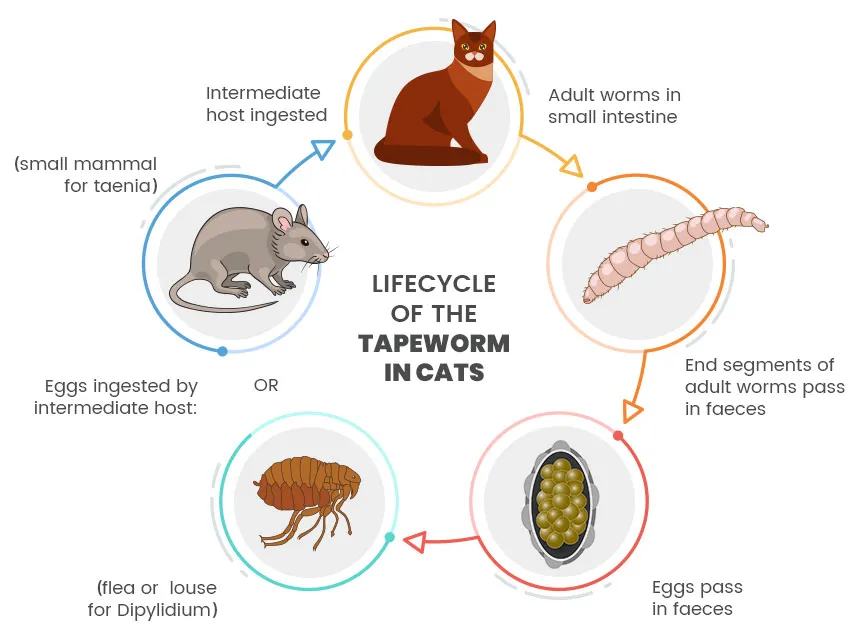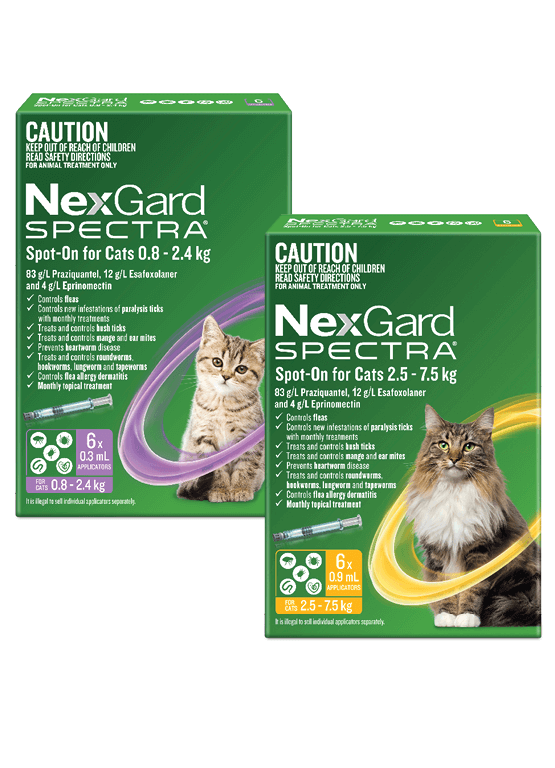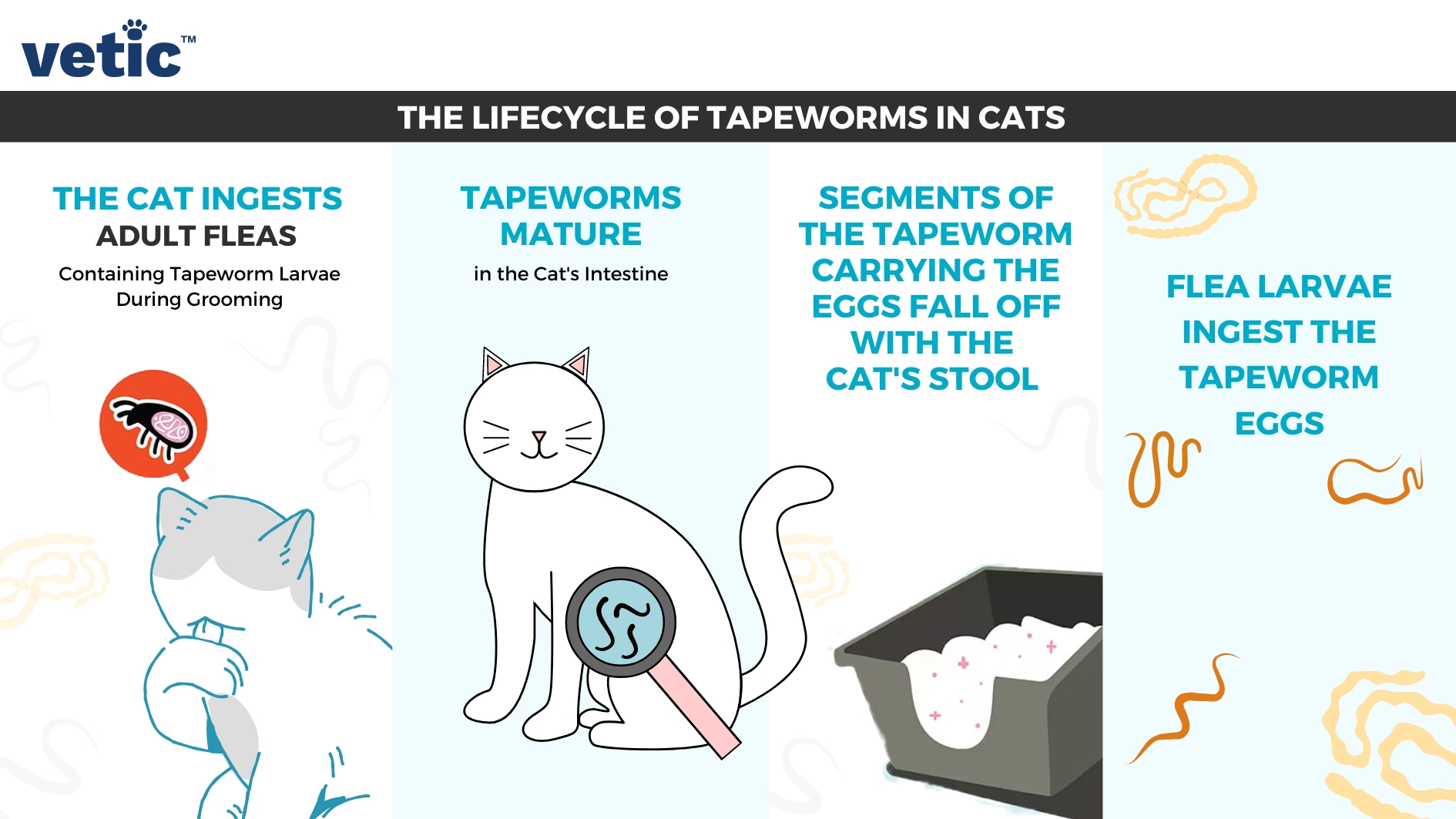Do you suspect your feline friend might have tapeworms? You’re not alone, and there’s no need to panic.
Spotting the signs early and knowing how to treat tapeworms in cats can make all the difference in keeping your beloved pet healthy and happy. When you understand the issue, you can tackle it head-on and ensure your cat gets back to its playful self in no time.
This guide will walk you through the steps to effectively treat and prevent tapeworms, giving you peace of mind and your cat the comfort it deserves. Ready to become the hero your cat needs? Read on to learn more!

Credit: www.animigo.co.uk
Identifying Tapeworms In Cats
Identifying tapeworms in cats is crucial for their health. These parasites can cause discomfort and health issues. Early detection leads to effective treatment. Understanding symptoms and types is essential.
Symptoms Of Tapeworm Infestation
Cats with tapeworms may show various signs. Look for rice-like segments in their feces. These are often around the anus. Cats might lick or bite at their anus. They may also drag their rear across the floor. Increased hunger is another sign. Cats may eat more but lose weight. Vomiting and diarrhea can occur. Watch for these symptoms closely.
Types Of Tapeworms In Cats
Several types affect cats. The most common is Dipylidium caninum. Cats get this from fleas. Another type is Taenia. Cats get this from hunting rodents. Echinococcus is less common. It can be dangerous to humans too. Knowing the type helps in choosing treatment. Each requires specific care.

Credit: nexgard.com.au
Causes Of Tapeworms In Cats
Tapeworms in cats often result from ingesting infected fleas. Symptoms include weight loss and visible worms in feces. Effective treatment involves prescribed deworming medication from a vet, ensuring your pet’s health improves rapidly. Regular flea control and hygiene help prevent future infestations.
Understanding the causes of tapeworms in cats is essential in preventing these pesky parasites from affecting your feline friend. Cats are curious creatures, and their natural instincts can sometimes lead them straight into situations where they might contract tapeworms. Knowing how these parasites find their way into your cat’s system can help you take proactive steps to keep them safe and healthy.Transmission Through Fleas
The most common way cats get tapeworms is through fleas. Fleas serve as intermediate hosts for tapeworm eggs. When your cat grooms itself and accidentally ingests a flea, it’s possible they have swallowed a tapeworm egg. Consider the last time you noticed your cat scratching more than usual. It might be more than just an itch. Flea infestations can quickly lead to tapeworms if not addressed promptly. Have you checked your cat for fleas lately? Regular flea prevention is crucial, not just for your cat’s comfort, but also to prevent tapeworms.Ingestion Of Infected Animals
Cats are natural hunters. This means they might catch and eat small animals like mice or birds. Unfortunately, these prey animals can carry tapeworms, and your cat can ingest them along with the prey. Think about your cat’s outdoor adventures. Does your cat have access to the great outdoors where they might hunt? While providing your cat with some outdoor stimulation is beneficial, it’s also important to be aware of the risks. Regular check-ups with your vet can ensure your cat hasn’t picked up any unwanted parasites. Understanding these causes allows you to be proactive in your cat’s care. By tackling fleas and monitoring your cat’s hunting habits, you can significantly reduce the risk of tapeworms. How will you protect your feline friend today?Diagnosis Methods
Diagnosing tapeworms in cats is crucial for effective treatment. Understanding the diagnosis methods helps pet owners take the right steps. This section explores how veterinarians determine the presence of tapeworms in cats.
Veterinary Examination
Veterinary examination is a key step in diagnosing tapeworms. The vet checks the cat’s physical condition and symptoms. They observe the cat’s overall health, checking for signs like vomiting or diarrhea. The examination might include looking for tapeworm segments near the cat’s anus. These segments resemble grains of rice and indicate tapeworm presence. This physical check is quick and essential for early detection.
Stool Sample Analysis
Stool sample analysis offers detailed insights into the cat’s condition. The vet collects a stool sample from the cat for testing. This analysis identifies tapeworm eggs or segments in the feces. Microscopic examination confirms the presence of tapeworms. Stool sample analysis is precise and helps in confirming the diagnosis. It provides clarity on the type of tapeworm infecting the cat.
Treatment Options
Tapeworms in cats require prompt treatment. These parasites can cause discomfort and health issues. Various treatment options are available. Each has its benefits. Let’s explore some effective ways to treat tapeworms in cats.
Prescription Medications
Prescription medications are often recommended by veterinarians. These medicines are effective in eliminating tapeworms. They work quickly and are safe for your cat. Veterinarians usually prescribe tablets or injections. Follow the vet’s instructions carefully. This ensures your cat recovers quickly.
Over-the-counter Solutions
Over-the-counter solutions are available in pet stores. They include tablets and liquid formulas. These products target tapeworms efficiently. Read the label before buying. Ensure it’s suitable for your cat’s age and weight. Consult a vet if you’re unsure. This helps avoid potential side effects.
Home Remedies And Prevention
Tapeworms in cats can be a pesky problem, but tackling them with home remedies and preventive measures is a wise approach. You might be surprised to learn that some simple changes in routine can help keep these parasites at bay. Whether it’s adjusting your cleaning habits or ensuring your cat is free of fleas, these strategies are essential for a healthy and happy pet.
Maintaining Hygiene
Keeping your home clean is crucial in the fight against tapeworms. Regularly vacuum carpets and upholstery to remove any flea eggs or larvae that might be lurking. Wash your cat’s bedding frequently in hot water. This not only gets rid of existing fleas but also prevents new ones from making a home.
Consider using a steam cleaner on surfaces that can handle it. The heat is effective in killing parasites. A friend once shared her secret of using white vinegar as a natural disinfectant—it’s cheap and cat-safe. Have you tried it yet?
Flea Control Measures
Fleas are the main carriers of tapeworms, so controlling them is vital. Use a flea comb to regularly check your cat’s fur. Have you noticed how your cat reacts during flea season? It’s worth paying attention to their behavior.
Applying topical flea treatments can be effective. A neighbor swears by monthly flea medications as a preventive measure. She noticed her cat scratching less and appearing more comfortable. You might find similar success.
Don’t forget to treat your yard, especially if your cat goes outside. Natural options like diatomaceous earth can help keep fleas away without harsh chemicals. How often do you think about what’s lurking in your garden?
By focusing on cleanliness and flea control, you can significantly reduce the risk of tapeworms. Implement these practical tips and watch your cat thrive. Are you ready to take these steps for your furry friend?
Aftercare And Monitoring
After treating your cat for tapeworms, aftercare and monitoring are crucial. Ensuring your feline friend’s health remains stable is vital. This phase helps prevent reinfection and ensures a full recovery. Pay attention to your cat’s behavior and physical condition. Regular check-ups and vigilance can keep tapeworms at bay.
Regular Health Check-ups
Schedule regular vet visits for your cat. These check-ups help detect any health issues early. Your vet can provide advice on maintaining your cat’s health. Frequent examinations ensure your cat remains tapeworm-free. Regular check-ups also build a health history, which aids in future diagnostics.
Signs Of Recurrence
Stay alert for signs of tapeworm recurrence. Watch for weight loss or a dull coat. Notice if your cat is scooting or has a bloated stomach. These can indicate a tapeworm problem. Catching these signs early can prevent complications. Quick action can lead to a swift return to health.
When To Consult A Veterinarian
A veterinarian should be consulted for treating tapeworms in cats. Symptoms like weight loss and vomiting are concerning. Proper medication is crucial for effective treatment and prevention of future infestations.
When dealing with tapeworms in cats, knowing when to consult a veterinarian is crucial. While some cases can be managed at home, others require professional guidance. Recognizing the signs that need immediate veterinary attention ensures your cat’s health and wellbeing.Severe Symptoms
If your cat shows severe symptoms, seek veterinary help immediately. Symptoms like vomiting, diarrhea, or weight loss can be alarming. Cats might become lethargic or show a lack of appetite. These signs suggest the infestation is serious. A veterinarian can provide the necessary treatment. They can also rule out other health issues.Persistent Infestation
A persistent infestation warrants a visit to the vet. If the tapeworms return after treatment, there may be an underlying cause. The environment might need attention, or the medication might not be effective. A vet can assess and prescribe a different solution. They will ensure the infestation is fully addressed. Regular check-ups can prevent future issues. Your cat’s health is worth the effort.
Credit: vetic.in
Frequently Asked Questions
How Do You Treat Tapeworms In Cats At Home?
Consult your vet for appropriate deworming medication. Follow their instructions for dosage and administration. Ensure your cat’s environment is clean. Regularly wash bedding and vacuum the house. Prevent future infestations by keeping your cat indoors and controlling fleas. Always prioritize professional veterinary advice for effective tapeworm treatment.
Do I Need To Clean My House If My Cat Has Tapeworms?
Yes, cleaning your house is essential if your cat has tapeworms. Vacuum carpets and wash bedding regularly. Disinfect litter boxes and any surfaces your cat frequently uses to prevent reinfestation. Regular cleaning helps eliminate eggs and larvae, ensuring a healthier environment for both you and your pet.
How Contagious Is Tapeworm In Cats?
Tapeworms in cats are not highly contagious. Cats can contract tapeworms by ingesting infected fleas or rodents. Regular flea control and proper hygiene reduce risk. Humans are rarely affected but can get tapeworms from ingesting infected fleas. Always consult a vet for treatment if tapeworms are suspected in your cat.
How Long Does It Take For A Cat To Get Rid Of Tapeworms?
Cats usually get rid of tapeworms within 24 hours after taking prescribed medication. Always consult a vet for proper diagnosis and treatment to ensure your cat’s health. Regular check-ups help prevent reinfection and maintain your cat’s well-being.
Conclusion
Treating tapeworms in cats is crucial for their health. Regular vet visits help catch issues early. Use prescribed medications only. Over-the-counter options may not work. Keep your cat’s environment clean. This prevents reinfection. Regular flea control is key. It stops tapeworm spread.
Monitor your cat’s behavior closely. Changes might signal a problem. A healthy diet supports recovery. Your cat deserves the best care. Stay informed and proactive. Your furry friend relies on you. A tapeworm-free cat is a happy cat. Take action today for their well-being.
